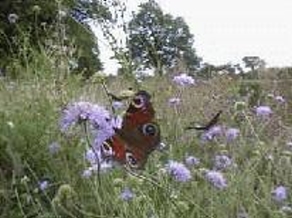Horticultural Advice:
Plan ahead, expect the following work to
establish a meadow
Most seed mixtures when they grow and develop, require at least one cut at the end of each summer.
After the first years full summer growth, cut
it to 10cm (removal of debris greatly helps).
In the second year, weeds and wild grasses
grow, a meadow may require cutting twice. (spring and Autumn) (removal of debris
is essential).
In the third year and maybe fourth year (to control grass)
cut when grass is in full flower. then once again thereafter.
Your meadow in most cases will have formed a
flora able to cope with Irish weather and soils.
'Short cut' and 'annual' mixtures, and mixtures for shade, flooded and other specialist areas require specific
instructions
Removal of debris is essential, After Cutting: Clean up. The meadow should be raked up and all dead materials and thatch removed, then scratch the soil to allow new seeds to grow.
Plan where you can re-cycle the wildflower hay

Sowing into existing grass (for Skilled Growers only)
The 'Cut and Sow' Wildflower Seed Mixture can be sown into existing 'weed
free' grassy swards, without killing off all the existing weeds and vegetation,
.
However, the best results are achieved on weed free clean soil.
Novice Approach.
Weed free clean soil. ( Recommended Novice Approach)
Weed Killing and removal of Existing Vegetation
In all cases, it is best to eliminate any grass or weeds.
Before sowing please clear the site of any invasive or pernicious weeds such as Gorse, Couch grass, thistle, dock, nettle, Rushes and or Reeds, or any other
very difficult to eradicate weed.
Gorse. difficult to eradicate, a mixture will be recommended that requires cutting to control this weed.
Pull seeding as they emerge.
Dock. difficult to eradicate in early years, if infestation is controlled, by killing plants and stopping flowering/seed set, dock will cease to be a
problem.
A grassy meadow will help control Dock Weed. Dock sets seed whilst in flower.
Creeping Buttercup < difficult to eradicate, Creeping Buttercup may re-colonise the meadow, especially in your soils. A specific cut is required
when Creeping Buttercup is in full flower. Do this in the early years of the meadow even if it means sacrificing wildflowers.
Nettles. difficult to eradicate, regular cutting will remove nettles.
Couch grass. very difficult to eradicate, remove as much root material before sowing, spot and weed wipe control after sowing.
Thistle < depends on species, can be attractive, but will become a nuisance
if uncontrolled.
As many of our customers choose to use non natural weed control methods, we provide general advice to assist.
We know from experience that in most cases 'ecological' weed control methods are
better than quick fix chemicals.
Eco' methods may be more costly and time consuming. Our web site details some
of these cultivation techniques.
In the long run, if you first clear the site of all weeds using herbicide and
then natural weed control, the meadow has a better chance to establish.
At DBN we believe that the benefit of using certain herbicides to prepare, establish and maintain a meadow in the early years, out-ways the
negatives as the amount of wildlife attracted to our customers meadows is exponential.
DBN may recommend the use of a weed killer, but under law, cannot recommend which variety.
To be fair, the best advice we can give is to use a herbicide only once or twice, to weaken the weeds, then remove the roots of the stronger weeds
that herbicides do not kill out right.
Site specific weeds, Species which are site specific and have a strong foothold
will most likely be native to the site, we recommend working with them, in most cases, regular cutting will control and
favour grass and other species.
EU regulations govern advice supplied when recommending the use of herbicides.
Design By Nature does not recommend the use of specific weed killers/herbicides
or similar products, or cultivation techniques which negatively effect the environment. in brief, use the manufacturers or suppliers instructions in
regard to the chemicals employed.
|